Abstract
In agrotechnical practice, it was found that between qualitative indices, which express the sowing precision achieved by precision planters determined in the laboratory, and those determined under operating conditions, that there are certain differences, which are sometimes quite significant. The decrease in the value of the quality indices was manifested by the increase of the number of mistakes, either of the number of double planting holes (with at least two seeds), or of the number of missing planting holes. Both cases are unfavorable for the agricultural producer, generating production losses. This paper discusses the influence of the degree of soil grinding on sowing precision in operating conditions, by determining the spectrum of the vibrations induced in the mechanical structure of row units of a precision planter in contact with the soil of three different plots for three working speeds: 4, 6, and 8 km·h−1. Later, the vibrations were simulated under laboratory conditions, on the stand, by means of rubber hemispheres (with diameters between 30 and 100 mm, corresponding to soil fractions resulting from the determination of the degree of soil grinding) mounted on rubber bands, which actuated the seed meters, for testing under an accelerated regime, outside of the optimal agricultural periods (out of season: beginning mid-May until the end of March), in order to obtain the accuracy of the precision planters. It was found that the sowing precision determined in stationary conditions on the stand, and on a plot with an appropriate degree of seedbed preparation, decreased between 2.92% (at 4 km·h−1) and 6.67% (at 8 km·h−1). The main objective of the tests was to reduce labor costs, which was necessary for the staff involved for determining the qualitative indices of work in real field operating conditions, eliminating fuel consumption, while reducing the duration of testing dependent on meteorological factors (season, temperatures, and precipitation, etc.).
1. Introduction
Agricultural technological processes have a special feature that fundamentally distinguishes them from the actual industrial ones: they suffer from the influences of many disruptive factors whose study requires complicated procedures and rather complex analysis mechanisms. To maximize crop yields and meet increasing demands for food, smart agricultural technologies, which imply the integration of technology as well as the application of agricultural data (the agriculture and farming sector is moving towards the IoT-connected ecosystem), has the ultimate aim of increasing food quality [1,2,3,4,5]. Therefore, all results of field tests must be rigorously interpreted in direct connection with the conditions under which they were performed.
The precision sowing technique involves sowing one or more weeding plant seeds (corn, sunflower, sugar beet, potato, soybean, chickpeas, cotton, tobacco, sorghum, or melons) in evenly spaced planting holes on equidistant rows, representing the current sowing method, unlike the sowing technique in rows that performs the distribution of seeds in equidistant rows, in continuous flow [6].
Research promotion, in terms of conceptual design of precision planters, aims at optimizing the qualitative working indices provided in the modern agrotechnical norms [7,8].
Experimental research on the seed meters precision planters has highlighted the following ideas:
- Mechanical seed meters require a much more precise adaptation of hole sizes to the seed sizes of the crops to be sown [9];
- The diameters of the holes in the distributing discs of mechanical seed meters must be approximately 10% larger than the seed diameters [10];
- Sowing precision is higher for pneumatically assisted seed meters [10];
- Seed meters’ drive can be mechanical, electrical or hydraulic [11];
- Eliminating seed surplus from the holes of the distributing discs is done by means of a singulator of different shapes;
- The removal of broken seeds and residues that can clog the holes of the distribution discs is done by means of: ejector wheels that are interchangeable depending on the crop to be sown [12]; ball rod devices actuated by means of a spring which enters the holes of the distributing disc after passing the seed release area into the guiding tube [13,14]; and controlled penetration of free air into the depression chamber [15];
- Elimination of seed compaction inside the seed meters is ensured by mechanical means (agitators mounted on the drive shaft of the distributing disc, and vibrating mechanisms) and pneumatic means [16];
- To avoid collision of the seeds with the walls of their guiding tube towards the furrow and to manage the speed of seed inside the guiding tube, row units were built where the seed guiding tube was replaced with a brush belt that places the seeds at the bottom of the furrow according to agrotechnical norms [17,18];
- The modular construction of the seed meters allows: rapid replacement of the distributing discs when different crops are sown, hence the distribution of various types of seeds; quick check of seed meters when disturbances of the optimal sowing process are found; easy filling and emptying at the beginning and end of sowing work; and the rapid cleaning of seed meters [19,20].
Through their informational content, qualitative and quantitative in nature, the experimental research in the field of precision sowing aims to increase the efficiency of different constructive variants of seed meters by determining their qualitative working indices [21,22,23,24,25].
The factors that influence the sowing precision can be evaluated by comparative studies between various types of seed meters through laboratory research (on a specialized stand) [26,27,28].
In order to obtain a uniform distance between plants in a row, the precision planters manufactured thus far were equipped with different types of seed meters (mechanical and pneumatic).
The efforts to continuously improve seed meters have been aimed at maximizing weed plant production [29,30,31]. To obtain a perfect spacing between plants, each seed must be separated and then launched from the seed meter into the seed guide tube in the furrow opened by the coulter, after a precise and repeatable period of time and trajectory [32,33].
Studies showed that the sowing accuracy achieved by precision planters at traditional working speed falls within the agrotechnical norms, and the problems that appear with its increase were caused mainly by sliding and vibrations from drive chains [34,35].
The influence of the planter working speed on the qualitative parameters of the sowing process was evaluated in theoretical research by dynamic and mathematical modeling of the oscillating system of the row units and experimental research carried out both on stand (in the laboratory) and under field conditions [36].
The sowing work can be done with or without the previous processing of the seedbed, and the placement of the seeds is done at a constant depth, at the base of a loose soil layer and above a more compact soil layer [37].
Sowing depth and seed spacing, in turn, play an important role in the amount of sunlight received; any delay in seedling development may be of major importance in competition with neighboring weeds or plants, which may adversely affect the yield of future crops [38,39,40].
The soil resistance (variable depending on the region) causes the appearance of unwanted vibrations in the working parts of the row units (coulter), which causes variations in the depth of seed placement at the bottom of the furrow [41].
The physical properties of the seeds on the sowing precision were tested using DEM and triaxial ellipsoidal particle models to simulate the movement of the seeds in a vibrating tray [42]. The dimensions of the seeds (different, depending on the area where the sowing work is performed) seriously restricts the sowing precision [43].
The individual control and monitoring of each row unit of the planter, as well as the need to increase the working speed of precision planters, determined the planter manufacturers use of electronic seed metering systems with a role in solving the mechanical limitations related to the surface on which the sowing work is performed [44,45,46].
The singulation systems for electric drive seed metering systems have substantially fewer moving parts and can potentially respond more quickly than other drive mechanisms [47].
The possible causes of distance non-uniformity between the seeds in a row were highlighted through a study by varying the depression in seed meters’ feeding chamber and the working speed, investigating how the fall trajectories of vacuum seeds are affected, from two different viewing angles, under laboratory and field conditions [48].
Numerous studies and experimental research conducted to determine the performance of precision planters have provided information on how the seed meter behaves under laboratory or field conditions [49,50]. These studies focused mainly on the pressure or depression applied to the faces of the seed distributing disc [51,52,53].
In a study in which the coefficient of variation of the distance between the seeds, their fall speed, and the coefficient of variation of the seed fall speed, decreased with the increase of the speed of the distributing disc, a method of testing the sowing precision, which incorporated the technology of machine vision, pattern recognition, and automatic control, was developed [54].
At present, the companies producing precision planters have a constant preoccupation with increasing and optimizing the quality of the products, with the development and continuous improvement of the seed meters playing an extremely important role.
The purpose of these concerns derives from the need to obtain the highest possible yields for sown crops, which are obtained by strictly observing the norms of plants per hectare, with the rows sown as straight as possible, at equal distances from each other, and the distance between plants strictly observed, according to agrotechnical norms [55,56,57,58].
This paper aimed to determine and thoroughly analyze the different degree of tillage intensity of seedbed preparation, and its simulation in laboratory conditions, in order to attempt an accelerated regime, outside of the optimal agricultural periods and row units of precision planters.
2. Materials and Methods
In order to determine the influence of the degree of soil grinding that occurs under operating conditions, it is necessary to know the variation spectrum of the vibration induced in the mechanical structures of precision planters at contact with the ground during movement on different work plots with a different degree of seedbed processing.
The experimental research was performed on an experimental model of a precision planter, SEMA 8, with pneumatic seed meters, vertical discs with holes, lamellar singulator, and 8 row units.
Each row unit consists of the following main parts: hopper (seed tank), seed meter, seed transport tube, furrow opener, seed cover working part, and compaction wheel (Figure 1).
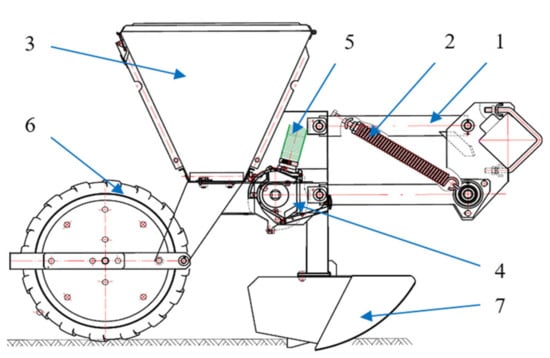
Figure 1.
Scheme of the studied row unit: (1) frame; (2) springs; (3) seed supply box; (4) seed meter; (5) vacuum channel flexible tube; (6) soil compaction wheel; and (7) furrow opener.
The sowing precision was determined, under operating and laboratory conditions, for three row units of the studied planter (coded SO, SV, BV), under the same conditions as those in which the field sowing work was carried out (corn crop). Romania, being one of the largest corn producers in the European Union, with approximately 17 million tons produced in 2019, had a sowing rate of 50,000 pl·ha−1, and working speeds of 4, 6, and 8 km·h−1 as normal working conditions [59].
These tests were necessary to establish the difference between the sowing precision determined when stationary, as in [60], on the stand, and the actual precision when simulating in laboratory, on the same stand, the actual operating conditions determined in the field.
By moving the planter, the support wheels, which are also drive wheels, put into operation a common shaft which, by means of a gearbox, actuates the drive shaft that runs the seed meters.
The vacuum generator creates the depression required for the operation of pneumatic seed meters. Actuating the distribution discs of the row units, the seeds are placed at equidistant distances in the furrow.
The compaction and level wheel is adjusted to ensure the working depth required by the agrotechnical norms.
Each hole drives a seed, as a result of the depression that is created near the hole of the seed meter’s distributing disc.
The evacuation of the seeds from the device is done under the action of their own weight, when the holes to which the seeds have adhered come out of the area where the depression is created.
Figure 2 shows the scheme of the studied row unit’s seed meter.
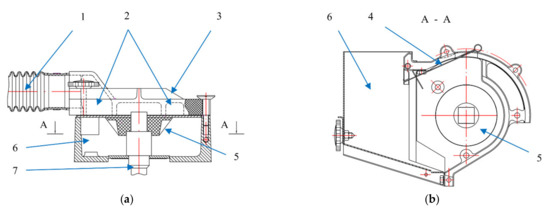
Figure 2.
Scheme of the studied row unit’s seed meter: (a) Top view; (b) Lateral view; (1) vacuum hose; (2) depression chamber; (3) seed meter cover; (4) lamellar singulator; (5) agitator; (6) seed feeding chamber; and (7) seed meter shaft.
2.1. Tests under Operating Conditions
For this purpose, acceleration transducers (triaxial accelerometers model 356B10) were mounted on the precision planter (with 8 row units), with pneumatic seed meters, vertical discs with holes, and lamellar singulator.
From experimental practice, it is known that the vibrations in the transverse direction are much smaller than those in the other two directions: longitudinal and vertical [61,62,63], and, thus, the acceleration measurements were performed on three channels as follows:
- On the SO, SV, and BV row unit in the horizontal and vertical direction;
- On the planter’s frame only on the vertical direction.
The acquisition of the raw experimental data was obtained with the help of the following measurement chain composed of:
- Acceleration transducer (Figure 3);
 Figure 3. Scheme of PCB triaxial accelerometer model 356B10 [64].Table 1 shows the specifications of the PCB triaxial accelerometer, model 356B10.
Figure 3. Scheme of PCB triaxial accelerometer model 356B10 [64].Table 1 shows the specifications of the PCB triaxial accelerometer, model 356B10. Table 1. Specifications of the PCB triaxial accelerometer model 356B10 [64].
Table 1. Specifications of the PCB triaxial accelerometer model 356B10 [64]. - PCB signal conditioner model 480B21 with a frequency range of up to 100 kHz (Figure 4);
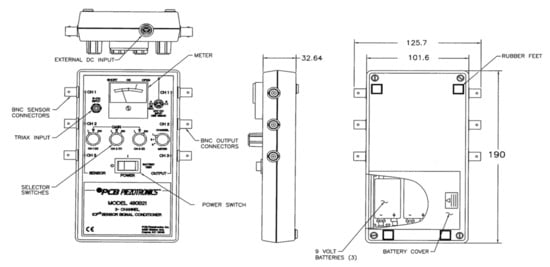 Figure 4. Scheme of PCB signal conditioner model 480B21 [65].Table 2 shows the specifications of PCB signal conditioner model 480B21.
Figure 4. Scheme of PCB signal conditioner model 480B21 [65].Table 2 shows the specifications of PCB signal conditioner model 480B21. Table 2. Specifications of PCB signal conditioner model 480B21 [65].
Table 2. Specifications of PCB signal conditioner model 480B21 [65]. - Data recording module (NI 9233 data acquisition device + computer);The NI USB-9233 data acquisition device provides a USB interface for four channels of 24-bit analog inputs with integrated signal conditioning, consisting of two components: an NI 9233 module and an NI USB-9162 carrier (Figure 5);
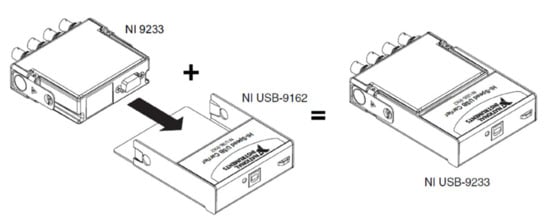 Figure 5. Scheme of NI USB-9233 data acquisition device with 4 analog input channels [66].
Figure 5. Scheme of NI USB-9233 data acquisition device with 4 analog input channels [66]. - Laptop with LabVIEW data acquisition software.The raw data acquisition software was developed in LabVIEW and contains the task of data acquisition and calibration of the three measurement channels from the accelerometer (DAQ Assistant), a virtual tool for real-time display of the power spectrum of vibrations on the 3 channels (Power Spectrum), a virtual tool for calculating real-time RMS values (Vibration Level), and a virtual tool for saving data in ASCII format. Within the program developed in LabVIEW, a data acquisition task was performed on three analog channels. The acquired data was filtered (low-pass filter to 5 Hz) and saved in an ASCII file.Figure 6 shows the program developed in LabVIEW for determining the vibration level.
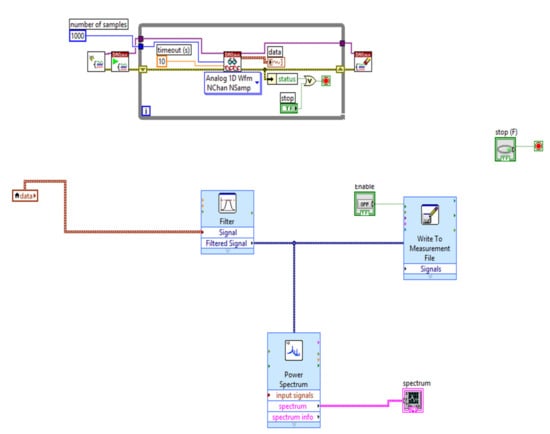 Figure 6. The program developed in LabVIEW for determining the vibration level.
Figure 6. The program developed in LabVIEW for determining the vibration level.
The signals were recorded in the computer, and their subsequent processing was performed in the laboratory, through the following steps:
- Channel demultiplications;
- Graphic editing;
- Obtaining the power spectrum for the registered acceleration signals.
The amplitude of vibrations recorded on the row units was mainly correlated with the degree of soil grinding.
Determination of the degree of soil grinding, Gms, was the proportion by weight of soil fractions with lump sizes of less than 20 mm, between 20 and 50 mm, 50 and 100 mm, and more than 100 mm in relation to the mass of the soil sample. The degree of grinding was calculated in % with the relation (according to SR 13230-94) [67]:
where:
mcxi—measured weight of soil lumps with reference lump size:
- Less than 20 mm;
- Between 20 and 50 mm;
- Between 50 and 100 mm;
- More than 100 mm from the soil sample, (kg);
mti—weight of the entire soil sample, (kg);
nme—number of measurements performed, (-).
To determine the degree of soil grinding, the following steps were followed:
- A soil sample with the dimensions of 1 m x 1 m was delimited (using the meter frame and the depth equal to the working depth of the planter asem = 8 cm);
- From the respective sample the soil fractions with dimensions smaller than 50 mm were separated from the lumps with dimensions larger than 100 mm;
- The degree of soil grinding was calculated, which represents the proportion by weight of the soil fractions, in relation to the total mass of the soil sample.
The weighing was performed with a portable balance, with a relative error of 1%. For the separation of the soil fractions, a set of sieves with round holes, 50 mm and 20 mm in diameter, was used.
The experimental research was performed on three plots with different degrees of seedbed preparation, with three repetitions for each plot. The working speeds at which the experiments were performed were 4, 6, and 8 km·h−1.
Table 3 shows the average values of the degree of soil grinding on the plots upon which the experiments were performed.

Table 3.
Degree of soil grinding.
Plot P2 represents the plot with an optimal degree of grinding on which the smallest amplitudes of vibrations were predicted and, implicitly, an optimal sowing precision.
2.2. Tests under Laboratory Conditions
The determination of sowing precision under laboratory conditions was made by means of a fully automated stand, which ensured testing conditions for all types of precision planter row units, consisting of the following components:
- A frame with the possibility of simulating the slope of the terrain between 0–11°;
- Two 5.5 kW variable speed motors: the first being used to drive the row units with an individual transmission, and the second for driving the seed meters of the row units with a centralized transmission, both being able to simulate working speeds between 2 and 12 km·h−1;
- Three SICK laser transducers, model FLG2-20025011, with a response time of <0.1 ms and a detection surface of 250 mm x 200 mm. Their role was to measure and transform the fall time interval between two seeds in space (multiplying the fall time by the forward speed) which, then, was compared with the reference space between the seeds in the row;
- A vacuum generator that could create a maximum depression of 5883 Pa (depression measured by means of a Prandtl-Pitot tube), the nominal speed being 4000 rev·min−1;
- A control panel with an operating terminal that processed the data received from the laser transducers and controlled the speed of the two electric motors.
Figure 7 shows the basic scheme of the stand for determining the sowing precision.
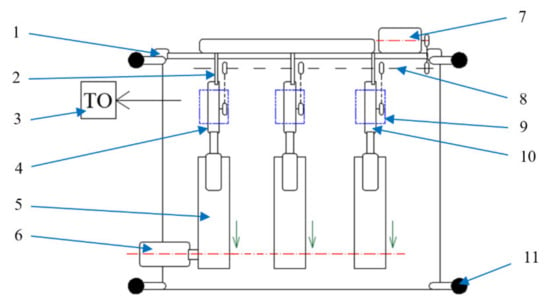
Figure 7.
The basic scheme of the stand for determining the sowing precision: (1) frame; (2) depression hose; (3) operating terminal; (4) individual transmission row unit; (5) rubber belt; (6) electric motor driving the individual transmission row unit; (7) electric motor for driving the centralized transmission row units; (8) seed meter drive shaft; (9) laser transducer; (10) centralized transmission row unit; and (11) support legs (adjustable).
To simulate, in the laboratory, the real operating conditions corresponding to the three plots where the sowing work was carried out, the drums and rubber bands, provided with two rows of holes in the contact area between them and compaction wheels with zero pressure tires, were mounted on the stand to determine the sowing precision.
PCB accelerometers (model 356B10) were mounted on the row units (on the SO row unit in the horizontal direction, on the SV row unit in the vertical direction, and on the BV row unit, on its support bar, in the vertical direction) and the seed meters were connected to the centralized transmission of the stand to determine the sowing precision.
Rubber hemispheres, with diameters ranging from Φ 30 to 100 mm, were randomly mounted on the rubber belt, until the power spectrum of the vibrations measured on the row units resembled the one measured in the field, when the belt was driven with speeds corresponding to the travel speeds of 4, 6, and 8 km·h−1 (Figure 8).
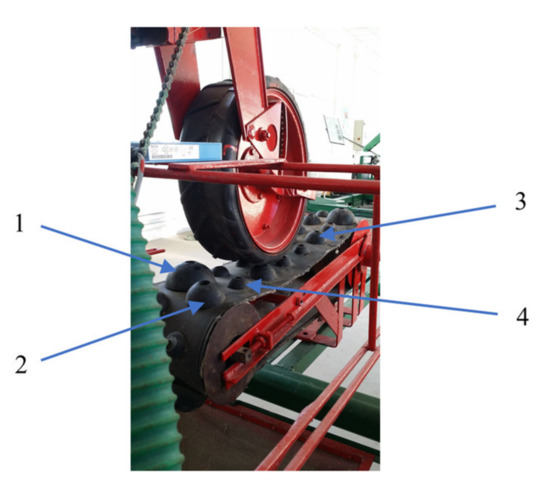
Figure 8.
Seed meter drive belt provided with rubber hemispheres: (1) hemispheres with Φ 100 mm; (2) hemispheres with Φ 80 mm; (3) hemispheres with Φ 50 mm; and (4) hemispheres with Φ 30 mm.
By means of accelerometers, the vibrations (accelerations) induced in the row unit were measured and the rubber hemispheres were repositioned on the belt until the vibrations power spectrums were similar to the ones of the plots actually sown. The operation was repeated to simulate the vibrations measured on the two other plots, determining, at the same time on the stand, the sowing precision in three repetitions for the row unit of the studied planter (according to ISO 7256/1-92) [68]. Thus, the sowing precision was determined, using as a reference element the theoretical (adjusted) interval between seeds in the row xref. By means of specialized software, the theoretical interval between seeds in a row, xj, was compared with the real interval between two successive seeds being determined on the stand by means of laser transducers, considering:
- Double sowing—any real interval: xj ≤ 0.5·xref;
- Correct sowing—any interval: 0,5·xref < xj ≤ 1.5·xref;
- Missing sowing—any real interval: xj > 1.5·xref.
3. Results
The statistical values of the vertical vibrations obtained (following field experiments) after processing the acceleration signals for each tested row unit are presented in Table 4.

Table 4.
Statistic values of vibrations.
Figure 9 shows the evolution of vertical accelerations in time, obtained from field experiments, for the working speed of 4 km·h−1 on plot P2.
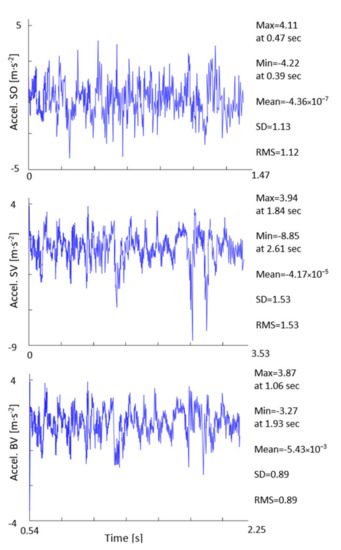
Figure 9.
Vibration evolution during sowing on plot P2 at the working speed of 4 km·h−1.
Figure 10 shows the power spectrum peak versus frequency of the recorded vertical vibrations, obtained in the field experiments, for the working speed of 4 km·h−1 on plot P2.
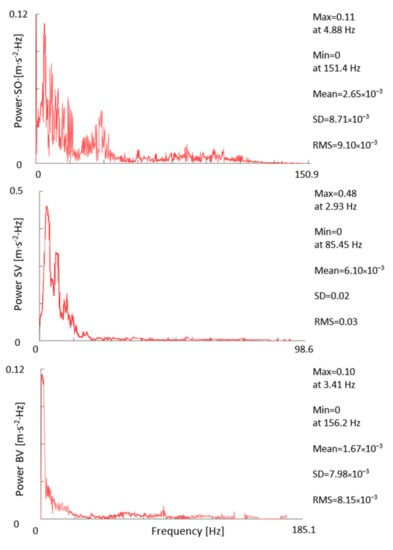
Figure 10.
Power spectrum of vibrations during sowing on plot P2 at the working speed of 4 km·h−1.
Due to the fact that the BV row unit had the lowest RMS values of the recorded vibrations, which affected sowing precision the least, the laboratory tests were performed on this row unit, both with and without vertical vibration simulation.
Table 5 presents the results of seed distribution and determination, in stationary conditions without vibration simulation, of the quality indices of the studied row unit, for a density of 50,000 corn plants·ha−1 and a working speed of 4 km·h−1.

Table 5.
Seed distribution and determination, in stationary conditions, of the quality indices of the studied row unit, for a density of 50,000 corn plants·ha−1 and a working speed of 4 km·h−1.
It was observed that the row unit had a slight tendency to reduce the interval between the seeds sown below the adjusted one Xaverage < 1, with the sowing precision being 95.36%.
For the sowing precision diagram of the BV row unit, for the density of 50,000 corn plants·ha−1 and the working speed of 4 km·h−1 (determined in stationary conditions without vibration), and using the Mathcad program, the equation for the sowing precision variation curve was obtained (Figure 11), with the number of seeds, ni, reported to the sowing intervals Xi. The equation represents a Gaussian distribution of the sowed seeds, desirable for this type of process.
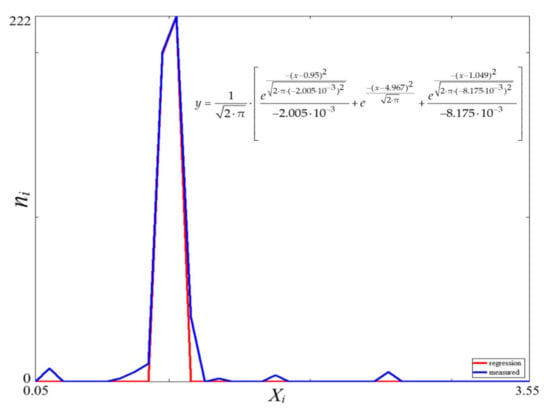
Figure 11.
Diagram of the studied row unit’s sowing precision (in stationary conditions) for the density of 50,000 corn plants·ha−1 and the working speed of 4 km·h−1, repetition 1.
It should be noted that the sowing precision determined in stationary conditions on the stand decreased (from 95.36% to 92.55%) with the increase of the working speed (from 4 km/h to 6 km/h), however, reaching the imposed quality limits.
Based on the recorded vibrations under exploitation conditions, the stand was calibrated and tests were performed on the same row unit.
Table 6 presents the results of seed distribution and determination by simulating the operating conditions of the quality indices of the BV row unit, for a density of 50,000 corn plants·ha−1 and the working speed of 4 km·h−1, on the plot with appropriate degree of seedbed processing.

Table 6.
Seed distribution and determination of the quality indices of the BV row unit, for a density of 50,000 corn plants·ha−1 and the working speed of 4 km·h−1, on the plot with appropriate degree of seedbed processing.
It was observed that the row unit had an increased tendency to reduce the interval between the seeds sown below the adjusted one Xaverage < 1, and the sowing precision was 92.51%.
The histogram, which characterizes the sowing precision, was obtained based on the number of used seeds and the spaces between them, but this time with vibration simulation based on real exploitation conditions.
Figure 12 shows the sowing precision diagram of the BV row unit for the density of 50,000 corn plants·ha−1 and the working speed of 4 km·h−1 (by simulating the operating conditions).
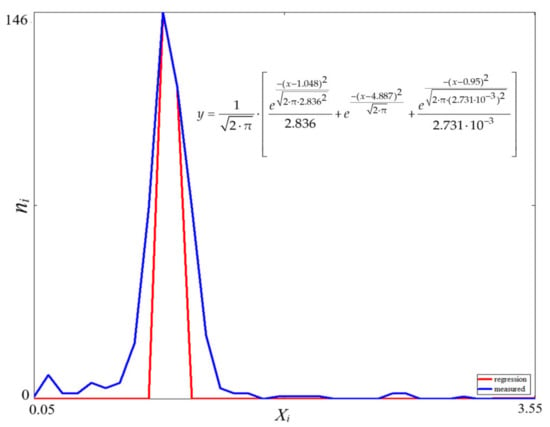
Figure 12.
Diagram of the studied row unit’s sowing precision (simulation of operating conditions) for the density of 50,000 plants·ha−1 and the working speed of 4 km·h−1, repetition 1.
Compared to Figure 11 (sowing precision determined in stationary conditions), Figure 12, which represents sowing precision obtained by simulating the real exploitation conditions in terms of supported vibrations, better represented the actual performance of the row unit. It could be observed that there was a slight decrease in performance due to the simulated vibrations. The equation corresponding to Figure 12 showed the same Gaussian distribution and can be used to predict the sowing precision with better accuracy.
Table 7 presents the values of the sowing precision by simulating the operating conditions on the stand.

Table 7.
Sowing precision determined by simulating the operating conditions on the stand.
It was observed that there was a decrease in the sowing precision with the increase of speed, which is a common aspect for all the working speeds used during the tests.
Referring to Section 2.2, it was found that:
- In the first stage, which aimed to measure the stresses, induced in the mechanical structures of the precision planters in contact with the soil during movement, on three work plots with a different degree of seedbed preparation:
- The accelerations (vibrations), induced by the action of the running surface in the row unit and in the bar–frame of the seeder, registered an increasing value in amplitude at the same time as the transition to a higher gear;
- The amplitude of the accelerations (vibrations), measured when sowing was made on a plot with a degree of inadequate seedbed preparation (plots 1 and 3), increased compared to the case of plot (2) and worked properly, having the granulation of soil particles less than 50 mm.
- In the second stage, when the row units were tested under simulated conditions in the laboratory (the tests being performed on the stand for determining the precision of planters, equipped with rubber bands on which rubber hemispheres were applied and positioned so that the vibrations would be similar to those made on the plots where the sowing work was carried out), on the row unit with a pneumatic seed meter, vertical discs, holes, and lamellar singulator at three working speeds (4, 6, and 8 km·h−1 respectively):
- The sowing precision determined in the stationary conditions, on the stand, decreased by approximately 3% by increasing the speed from 4 km·h−1 to 8 km·h−1;
- The sowing precision determined on a plot with an appropriate degree of seedbed preparation compared to a plot with an inadequate degree of preparation decreased by values between:
- 1.98% at 4 km·h−1;
- 2.17% at 6 km·h−1;
- 4.09% at 8 km·h−1;
- The sowing precision determined in the stationary conditions, on the stand, on a plot with an appropriate degree of seedbed preparation decreased as follows:
- 2.92% at 4 km·h−1;
- 4.75% at 6 km·h−1;
- 6.67% at 8 km·h−1;
- The sowing precision determined in the stationary conditions, on the stand, on a plot with an inadequate degree of seedbed preparation decreased as follows:
- 4.90% at 4 km·h−1;
- 6.93% at 6 km·h−1;
- 10.76% at 8 km·h−1.
4. Conclusions
As a result of research conducted in this paper, we found that:
- -
- The accelerations (vibrations) caused by the irregularity of the soil during the movement in the field for all the 3 plots where the experiments were conducted (with a different degree of seedbed preparation) increased with the transition to a higher gear (with the increase of the working speed);
- -
- In simulated experiments in the laboratory, the sowing precision was influenced by seedbed preparation and the working speed, which decreased as the seedbed was poorly processed (with larger irregularities), both stationary and during operation, for all three working speeds (4, 6, and 8 km h−1).
Sowing precision is a source of information and a criterion for assessing the behavior of the type of tested row unit. It is thus found that, by increasing the database on the working conditions in operation, precision planters can be tested under different working conditions simulated in the laboratory, thus reducing labor costs necessary for staff involved in determining the qualitative working indices in real operating conditions in the field, and eliminating fuel consumption, while also reducing the duration of testing that is dependent on meteorological factors (season, temperatures, and precipitation, etc.).
Author Contributions
Conceptualization, D.C., I.G. and S.Ș.B.; methodology, D.C., M.M. and I.V.; software, C.P., M.M. and G.I.; validation, V.V., G.P. and S.Ș.B.; formal analysis, I.G., I.V. and G.V.; writing—original draft preparation D.C., N.U. and G.V.; writing—review and editing, I.G. and N.U.; supervision, V.V. and G.P.; funding acquisition, C.P., S.Ș.B. and G.I. All authors have read and agreed to the published version of the manuscript.
Funding
The APC was funded by University Politehnica of Bucharest, within the PubArt Program.
Institutional Review Board Statement
Not applicable.
Informed Consent Statement
Not applicable.
Data Availability Statement
The study does not report any data.
Conflicts of Interest
The authors declare no conflict of interest. The funders had no role in the design of the study, nor in the collection, analyses, or interpretation of data and in the writing of the manuscript.
References
- Gupta, M.; Abdelsalam, M.; Khorsandroo, S.; Mittal, S. Security and Privacy in Smart Farming: Challenges and Opportunities. IEEE Access 2020, 8, 34564–34584. [Google Scholar] [CrossRef]
- Chukkapalli, S.S.L.; Mittal, S.; Gupta, M.; Abdelsalam, M.; Joshi, A.; Sandhu, R.; Joshi, K. Ontologies and Artificial Intelligence Systems for the Cooperative Smart Farming Ecosystem. IEEE Access 2020, 8, 164045–164064. [Google Scholar] [CrossRef]
- Sontowski, S.; Gupta, M.; Chukkapalli, S.S.L.; Abdelsalam, M.; Mittal, S.; Joshi, A.; Sandhu, R. Cyber Attacks on Smart Farming Infrastructure. In Proceedings of the 2020 IEEE 6th International Conference on Collaboration and Internet Computing (CIC), Atlanta, GA, USA, 1–3 December 2020; pp. 135–143. [Google Scholar]
- Choudhary, N.K.; Chukkapalli, S.S.L.; Mittal, S.; Gupta, M.; Abdelsalam, M.; Joshi, A. YieldPredict: A Crop Yield Prediction Framework for Smart Farms. In Proceedings of the 2020 IEEE International Conference on Big Data (Big Data), Atlanta, GA, USA, 1–3 December 2020; pp. 2340–2349. [Google Scholar]
- Gupta, M.; Awaysheh, F.M.; Benson, J.; Al Azab, M.; Patwa, F.; Sandhu, R. An Attribute-Based Access Control for Cloud Enabled Industrial Smart Vehicles. IEEE Trans. Ind. 2021, 17, 4288–4297. [Google Scholar] [CrossRef]
- Soyoye, B.O. Development of the Instrumentation Unit of a Motorized Precision Planter. Eur. J. Eng. Res. Sci. 2020, 5, 403–407. [Google Scholar] [CrossRef]
- Kachman, S.D.; Smith, J.A. Alternative Measures of Accuracy in Plant Spacing for Planters Using Single Seed Metering. Trans. ASAE 1995, 38, 379–387. [Google Scholar] [CrossRef]
- Kornienko, S.; Pashenko, V.; Melnik, V.; Kharchenko, S.; Khramov, N. Developing the method of constructing mathematical models of soil condition under the action of a wedge. East.-Eur. J. Enterp. Technol. 2016, 5, 34–43. [Google Scholar] [CrossRef][Green Version]
- Stout, B.A.; Cheze, B. CIGR Handbook of Agricultural Engineering; Volume III: Plant Production Engineering; The American Society of Agricultural Engineers: Saint Joseph, MI, USA, 1999; pp. 217–239. [Google Scholar]
- Murray, J.R.; Tullberg, J.N.; Basnet, B.B. Planters and Their Components. School of Agronomy and Horticulture; University of Queensland: Saint Lucia, Australia, 2006; pp. 8–30. [Google Scholar]
- Dobre, P. Energy Base and Horticultural Machinery, 2nd ed.; University of Agronomic Sciences and Veterinary Medicine of Bucharest: Bucharest, Romania, 2010; pp. 69–76. [Google Scholar]
- Sauder, D.A. Seed Meter. U.S. Patent No. 2014/0007801 A1, 9 January 2014. [Google Scholar]
- Dunham, L.J.; Barry, A.F. Air Seed Meter with Debris Clearing Device. U.S. Patent No. 7938073 B2, 10 May 2011. [Google Scholar]
- Eben, M.H.; Dunham, L.J.; Barry, A.F. Air Seed Meter. U.S. Patent No. 2005/0204972 Al, 15 March 2005. [Google Scholar]
- Peterson, B.D.; Nelson, B.W. Seed Metering Device and Seed Disk for Agricultural Seeder. U.S. Patent No. 8375874 B2, 19 February 2013. [Google Scholar]
- Crabb, R.J.; Ozers, G.; Slowinski, D.N.; Johnson, C.M.; Johnson, D.; Dunham, L.J.; Stuflebeam, J.F.; Olson, T.A.; Berry, S.D.; Brown, T.; et al. Seed Planter Apparatus and Method. U.S. Patent No. 6374759 B1, 23 April 2002. [Google Scholar]
- Garner, E.B.; Friestaf, M.E.; Mariman, N.A.; Zumdome, L.E. Air Pressure Differential Seed Meter. WO Patent No. 2012/135006 A2, 4 October 2012. [Google Scholar]
- Available online: https://www.youtube.com/watch?v=HpbyYRqX8QQ (accessed on 6 April 2021).
- Gilstring, G. Arrangement of a Seed Metering Device on an Agricultural Machine. U.S. Patent No. 2012/8336471 B2, 25 December 2012. [Google Scholar]
- Wilhelmi, M.J.; Brockmann, K. Air Seed Meter with Adjustable Singulator. EPO. Patent No. EP 2911498 B1, 24 July 2019. [Google Scholar]
- Bozdoğan, A.M. Seeding uniformity for vacuum precision seeders. Sci. Agric. 2008, 65, 318–322. [Google Scholar] [CrossRef][Green Version]
- Cârdei, P.; Manea, D.; Popescu, S.; Lazar, S. Mathematical model of the distribution device operating on the mechanical-pneumatic sowing machine SDC. INMATEH-Agric. Eng. 2011, 34, 5–12. [Google Scholar]
- Doerge, T.; Hall, T.; Gardner, D. New research confirms benefits of improved plant spacing in corn. Crop. Insights 2002, 12, 1–5. [Google Scholar]
- Morrison, J.E.; Gerik, T.J. Planter depth control: 2. Empirical testing and plant responses. Trans. ASAE 1985, 28, 1744–1748. [Google Scholar]
- Panning, J.W.; Kocher, M.F.; Smith, J.A.; Kachman, S.D. Laboratory and field testing of seed spacing uniformity for sugarbeet planters. Appl. Eng. Agric. 2000, 16, 7–13. [Google Scholar] [CrossRef]
- Babiciu, P.; Ganga, A.M.; Rada, P.N.; Pop, E.I.; Alexandrescu, I. Stand for Determining the Precision of Sowing of Row Units, for Weeding Plants. Patent No. RO 107515 B1, 25 May 1990. [Google Scholar]
- Karayel, D.; Wiesehoff, M.; Ozmerzi, A.; Muller, J. Laboratory measurement of seed drill seed spacing and velocity of fall of seeds using high-speed camera system. Comput. Electron. Agric. 2006, 50, 89–96. [Google Scholar] [CrossRef]
- Liu, W.; Tollenaar, M.; Stewart, G.; Deen, W. Impact of planter type, planting speed, and tillage on stand uniformity and yield of corn. Agron. J. 2004, 96, 1668–1672. [Google Scholar] [CrossRef]
- Li, D.; Geng, D.; Ma, B.; Li, Q.; Wang, Z.H. Study on performance monitoring system of corn precision seeder. J. Agric. Mech. Res. 2013, 11, 71–74. [Google Scholar]
- Miller, E.A.; Rascon, J.; Koller, A.; Porter, W.M.; Taylor, R.K.; Raun, W.R.; Kochenower, R. Evaluation of corn seed vacuum metering systems. In Proceedings of the 2012 ASABE Annual International Meeting, Dallas, TX, USA, 29 July–1 August 2012. [Google Scholar]
- Zubrilina, E.; Markvo, I.; Novikov, V.; Beskopylny, A.; Vysochkina, L.; Rudoy, D.; Butovchenko, A. Precise seeding planter with automated monitoring and control system. IOP Conf. Ser. Earth Environ. Sci. 2019, 403, 1–10. [Google Scholar] [CrossRef]
- Norris, C.P. Performance of some different types of peanut/maize planters in North Queensland. In Proceedings of the Agricultural Engineering Conference 1982: Resources–Efficient Use and Conservation, Armidale, Australia, 22–24 August 1982; Volume 82, pp. 149–154. [Google Scholar]
- Păunescu, D.D. Research regarding automated supervision of the work process of precision seed drills. INMATEH-Agric. Eng. 2009, 28, 14–17. [Google Scholar]
- Lacomi, C.; Popescu, O. A new concept for seed precision planting. Agric. Agric. Sci. Procedia 2015, 6, 38–43. [Google Scholar] [CrossRef][Green Version]
- Yang, L.; Xiantao, H.; Dongwing, Z.; Song, S.; Zhang, R.; Mantao, W. Development of mechatronic driving system for seed meters equipped on conventional precision corn planter. Int. J. Agric. Biol. Eng. 2015, 8, 1–9. [Google Scholar] [CrossRef]
- Opriș, O.S. Researches Concerning the Influence of the Oscillations of Seeding Machines for Weeding Plants on Qualitative Work Indices. Ph.D. Thesis, Transilvania University of Brasov, Brașov, Romania, 2007. [Google Scholar]
- Guul-Simonsen, F.; Jorgensen, M.H.; Have, H.; Hakansson, I. Studies of plough design and ploughing relevant to conditions in Northern Europe. Acta Agric. Scand. 2002, 52, 57–77. [Google Scholar] [CrossRef]
- Durr, C.; Boiffin, J.; Fleury, A.; Coulomb, I. Analysis of the variability of sugarbeet (Beta-Vulgaris L.) growth during the early stages. 1. Influence of various conditions on crop establishment. Agronomie 1992, 12, 515–525. [Google Scholar] [CrossRef]
- Koller, A.A.; Taylor, R.K.; Weckler, P.R.; Buser, M.D.; Raun, W.R. Design, performance prediction, and validation of a seed orienting corn planter. In Proceedings of the American Society of Agricultural and Biological Engineers Annual International Meeting, Kansas City, MI, USA, 21–24 July 2013. [Google Scholar] [CrossRef]
- Shrestha, D.S.; Steward, B.L. Automatic corn plant population measurement using machine vision. Trans. ASAE 2003, 46, 559–565. [Google Scholar] [CrossRef]
- Nielsen, S.K.; Munkholm, L.J.; Lamandé, M.; Nørremark, M.; Edwards, G.T.C.; Green, O. Seed drill depth control system for precision seeding. Comput. Electron. Agric. 2018, 144, 174–180. [Google Scholar] [CrossRef]
- Zhan, Z.; Yafang, W.; Jianjun, Y.; Zhong, T. Monitoring method of rice seeds mass in vibrating tray for vacuum-panel precision seeder. Comput. Electron. Agric. 2015, 114, 25–31. [Google Scholar] [CrossRef]
- Gong, Z.Q.; Chen, J.; Li, Y.M.; Zhao, Z. Analysis and research of a precision seeder horizontal adjustment mechanism. Mach. Des. Res. 2012, 28, 15–18. [Google Scholar]
- Kamgar, S.; Noei-Khodabodi, F.; Shafaei, S.M. Design, development and field assessment of a controlled seed metering unit to be used in grain drills for direct seeding of wheat. Inf. Process. Agric. 2015, 2, 169–176. [Google Scholar] [CrossRef]
- Mangus, D.L.; Sharda, A.; Flippo, D.; Strasser, R.; Griffin, T. Development of high-speed camera hardware and software package to evaluate real-time electric seed meter accuracy of a variable rate planter. Comput. Electron. Agric. 2017, 142, 314–325. [Google Scholar] [CrossRef]
- Velandia, M.; Buschermohle, M.; Larson, J.A.; Thompson, N.M.; Jernigan, B.M. The economics of automatic section control technology for planters: A case study of middle and west Tennessee farms. Comput. Electron. Agric. 2013, 95, 1–10. [Google Scholar] [CrossRef]
- Strasser, R.; Badua, S.; Sharda, A.; Mangus, D.; Haag, L. Performance of planter electric-drive seed meter during simulated planting scenarios. Appl. Eng. Agric. 2019, 35, 925–935. [Google Scholar] [CrossRef]
- Abdolahzare, Z.; Abdanan Mehdizadeh, S. Real time laboratory and field monitoring of the effect of the operational parameters on seed falling speed and trajectory of pneumatic planter. Comput. Electron. Agric. 2018, 145, 187–198. [Google Scholar] [CrossRef]
- Nielsen, R.L. Effect of Plant Spacing Variability on Corn Grain Yield; Purdue University Department of Agronomy: West Lafayette, IN, USA, 2004; pp. 1–10. [Google Scholar]
- Staggenborg, S.A.; Taylor, R.K.; Maddux, L.D. Effect of planter speed and seed firmers on corn stand establishment. Appl. Eng. Agric. 2004, 20, 573–580. [Google Scholar] [CrossRef][Green Version]
- Fanigliulo, R.; Pochi, D. Air-Flow Distribution efficiency of a precision drill used in the sowing of different graded seeds. J. Agric. Sci. Technol. B 2011, 1, 655–662. [Google Scholar]
- Singh, R.C.; Singh, G.; Saraswat, D.C. Optimisation of design and operational parameters of a pneumatic seed metering device for planting cottonseeds. Biosyst. Eng. 2005, 92, 429–438. [Google Scholar] [CrossRef]
- Xiaoyan, D.; Xu, L.; Caixia, S.; Haidong, H.; Qingxi, L. Mathematical model and optimization of structure and operating parameters of pneumatic precision metering device for rapeseed. J. Food Agric. Environ. 2010, 8, 318–322. [Google Scholar]
- Kaur, T.; Kumar, D. Design and development of calibration unit for precision planter. Int. J. Comput. Sci. Eng. Appl. 2013, 3, 11–17. [Google Scholar] [CrossRef]
- Becker, R. Apparatus for Separating and/or Counting Individual Elements of a Plurality. U.S. Patent No.3715057, 6 February 1973. [Google Scholar]
- Donadon, G. Sowing Machine. U.S. Patent No. D644253 S, 12 June 2011. [Google Scholar]
- Horsch, T. Seed Meter. U.S. Patent No. 7854206 B2, 21 December 2010. [Google Scholar]
- Schaefer, T.; Radtke, I. Seed Planting Apparatus, Systems and Methods. U.S. Patent No. 2017/9861025, 9 January 2018. [Google Scholar]
- Available online: https://www.madr.ro/culturi-de-camp/cereale/porumb.html (accessed on 31 March 2021).
- Biriş, S.Ş.; Ungureanu, N.; Vlăduţ, V. Study on the influence of mechanical vibrations to the energy required for soil tillage. In Proceedings of the 5th International Conference on Thermal Equipment, Renewable Energy and Rural Development, TE-RE-RD, Golden Sands, Bulgary, 2–4 June 2016; pp. 203–7941. [Google Scholar]
- Kennes, P.; Anthonis, J.; Clijmans, L.; Ramon, H. Construction of a portable test rig to perform experimental modal analysis on mobile agricultural machinery. J. Sound Vib. 1999, 228, 421–441. [Google Scholar] [CrossRef]
- Matache, M.G.; Voicu, G.; Epure, M.; Voicea, I.F.; Găgeanu, I.; Ghilvacs, M. Measuring vibrations level during transportation work for an electrical tractor. ACTA Tech. Corviniensis Bull. Eng. 2020, XIII, 27–30. [Google Scholar]
- Ruiz-Gonzalez, R.; Gomez-Gil, J.; Gomez-Gil, F.J.; Martínez-Martínez, V. An SVM-based classifier for estimating the state of various rotating components in agro-industrial machinery with a vibration signal acquired from a single point on the machine chassis. Sensors 2014, 14, 20713–20735. [Google Scholar] [CrossRef] [PubMed]
- Available online: http://www.pcb.com/Products/model/356B10/item_id/8704 (accessed on 1 February 2021).
- Available online: http://www.pcb.com/products.aspx?m=480b21 (accessed on 1 February 2021).
- Available online: http://www.ni.com/pdf/manuals/371569d.pdf (accessed on 1 February 2021).
- SR 13230-94 Agricultural Machinery. Plows. Technical Quality Conditions. Available online: https://magazin.asro.ro/ro/standard/8951 (accessed on 28 January 2021).
- STAS ISO 7256/1-92 Sowing equipment—Test methods—Part 1: Single Seed Drills (Precision Drills). Available online: https://magazin.asro.ro/ro/standard/12319 (accessed on 28 January 2021).
Publisher’s Note: MDPI stays neutral with regard to jurisdictional claims in published maps and institutional affiliations. |
© 2021 by the authors. Licensee MDPI, Basel, Switzerland. This article is an open access article distributed under the terms and conditions of the Creative Commons Attribution (CC BY) license (https://creativecommons.org/licenses/by/4.0/).